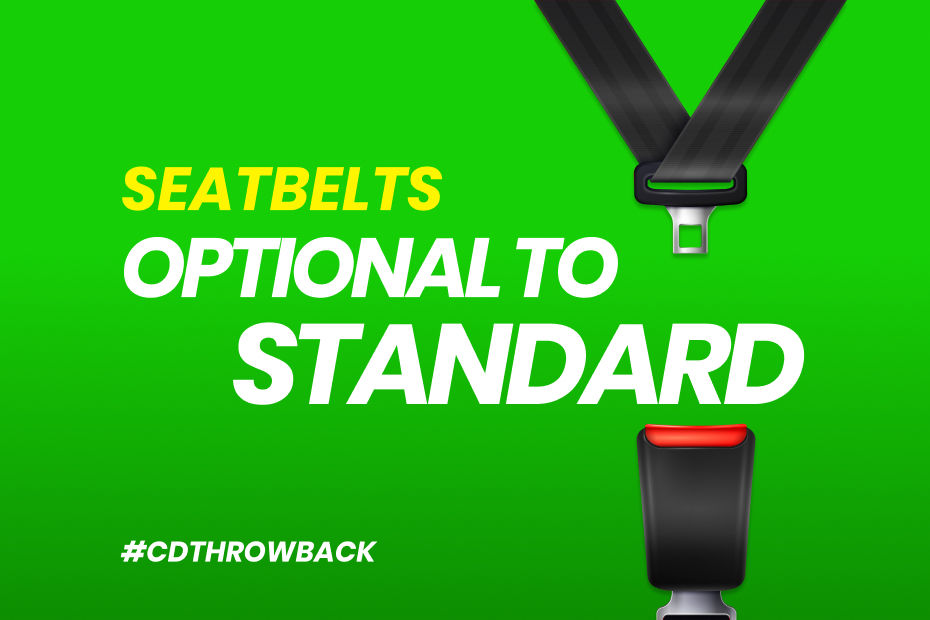Seatbelts: From An Optional Equipment To A Standard Feature, A Brief History
Modified On May 18, 2023 06:27 PM By Ansh
- Write a comment
While the three-point seatbelts we use today were invented in 1959, it took India 63 years to lay down plans to make them a standard safety feature for all the front facing occupants

Seatbelt, the most basic safety feature installed in a car, plays one of the most crucial roles in saving the lives of the occupants in case of an accident. Today, no matter which car you drive or even take a ride in, you will see there are seatbelts for all passengers. But this wasn’t always the case and there was a time when seatbelts were not considered as important. So let’s take a dive into the past and see how seatbelts came to be.
History Of Seatbelts

Seatbelts have been a part of cars from as early as the 1900s with their first patent being filed in 1885. But back then, cars used to have lap belts for all passengers. In 1946, these lap belts were made retractable for ease of use, but customers did not find seatbelts very appealing and either wanted to buy cars without seatbelts or had them removed from the car they purchased. Also, seatbelts were not a standard safety feature back then but were rather offered as additional equipment.

Fast forward to 1955, two Americans designed the first iteration of three-point seatbelts and later in 1959, an inverter named Nils Bohlin improved this design and came up with the three-point seatbelts we see in our cars today. Bohlin was also the chief design engineer at Volvo. While this design by Bohlin and Volvo was patented, the carmaker decided to leave the patent open so other brands could also use it and improve the safety of occupants on board.

The first car to be fitted with a three-point seatbelt was a Volvo PV 544 in the year 1959 and the first car to offer three-point seat belts as standard also came from Volvo the same year, called the Volvo 122. After the implementation of three-point seatbelts in Volvo cars, other carmakers started offering three-point seatbelts with their models.
Standardisation
As mentioned earlier in the article, seatbelts in their early years were not part of a car's standard equipment and were sold as an option. But that’s not true today. After Volvo made seatbelts a standard safety feature in their cars, other carmakers in America and European countries followed suit.
Also Read: From Zero to Six: How Airbags Became A Must-Have Feature In Indian Cars
By 1968, America made seatbelts for all cars standard; and in European countries, this was done in 1971. However, India made seatbelts standard pretty late. The Indian government made seatbelts standard in 1994, but this was only for the front passengers. The rule for making cars equipped with seatbelts for rear passengers came just over two decades ago, in 2002.

Today, all models from all car manufacturers in India come with seatbelts for all passengers as standard. Some cars have three-point seatbelts for all passengers, while some have a lap belt for the rear middle passenger. However, the latter will become non-existent soon, as the Indian government has plans to make three-point seatbelts a standard safety feature in all cars.
Wearing Seatbelt Becomes Mandatory
Having a seatbelt in a car is not enough. To save one’s life in case of an accident, one has to wear that seatbelt while driving or even while sitting comfortably in the passenger seat. But convincing people to wear seatbelts was even harder than making them standard, and some people still don’t prefer to wear them. In the early days, when cars were equipped with lap belts, most people used to find them uncomfortable and refused to put them on, and even after the introduction of three-point seatbelts, making people wear them was still not easy.

Now since people were not wearing seatbelts, and more and more cars were starting to come onto roads, accidents became more frequent and fatalities increased. To prevent more people from getting injured, laws needed to be introduced. The first country to make wearing seatbelts mandatory by law was Australia in its state of Victoria in 1970.
Also Read: A Small But Vital Safety Upgrade Added For All Hyundai Cars
After Australia, America made wearing seatbelts mandatory by 1980; and soon after, most of the countries in the world joined the list. In India, however, this law came into force in 2005 and even after its implementation, most people still don’t wear seatbelts.
Steps Taken By The Government
Since people in India don’t prefer to wear seatbelts, the rate of fatality in accidents increased. One such accident happened last year in September which led to the demise of Cyrus Mistry, who was the Chairman of Tata Group. This accident made the government make some amendments. Apart from making plans to make three-point seatbelts mandatory for all passengers, the Indian government took other measures to ensure the safety of passengers.

One of these measures was to make stricter laws against not wearing seatbelts for all passengers. Apart from this, the government also asked e-commerce websites like Amazon and Flipkart to stop selling seatbelt clips which can be used to stop the seatbelt reminder function and has also made seatbelt reminders for all seats a mandatory safety feature, which a lot of carmakers have already started implementing. This one feature encourages the driver and passengers to put on their seatbelts which helps keep them safe.
Current Data
While the government has started taking initiatives, the general public still needs to understand the importance of wearing a seatbelt. In a recent report from the Ministry of Road Transport and Highways (MoRTH), out of 55,628 people who were not wearing seatbelts and were involved in accidents in 2021, 16,397 people lost their lives, both drivers and passengers; and the rest suffered injuries. This accounts for almost a 30 per cent fatality rate for not wearing a seatbelt.

So since the government and carmakers are doing their part for ensuring passengers' safety, we have to take responsibility to follow the laws and make use of the safety equipment that’s been provided.
Also Read: Maruti Models To Soon Offer These Two Safety Features As Standard
This was the history of seatbelts, how the seatbelts we have today came into existence and what the Indian government and carmakers are doing to ensure the safety of passengers. Let us know what you think about this and remember to always wear a seatbelt whether you are driving or not.















